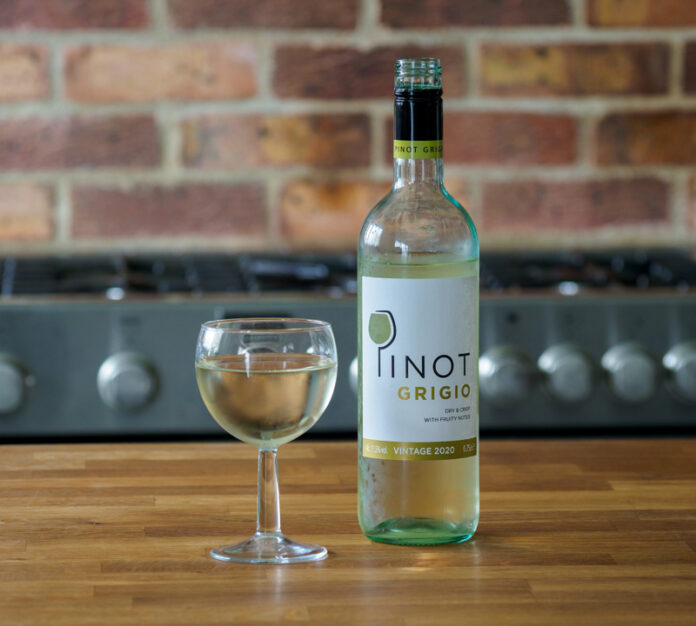It’s official: Pinot grigio is cool again.
Your reaction to the “again” part of this statement probably says something about your age, and even more about your lifestyle choices in the 1990s. For example, did you own at least one pair of boat shoes? Was Chicken Marbella (from “The Silver Palate Cookbook”) a dinner party staple you could whip up on the fly?
If you’re nodding emphatically, then you, dear boomer, not only lived through pinot grigio’s golden age — you nudged it along. (Remember all those bottles of Santa Margherita piled up in the recycling?) Cursive fonts, pale straw hues, squeaky-clean caramel apple flavors — 90s era pinot grigio was, as they say, a vibe.
Then Y2K arrived, prompting mass anxiety — and, inevitably, the need to quell it. One popular remedy — at least according to sales data — was pinot grigio. Between 1999 and 2000, sales surged 40 percent (Wine Spectator), initiating a decade of frenzied growth. By the time Real Housewives of New York City star Ramona Singer launched her own brand in 2012, pinot grigio had become a meme. But fame is not the same thing as social capital — and pinot grigio’s had long since dried up.
Now, shockingly, pinot grigio is making a comeback — but the new version is not what you’d expect. I’m talking, of course, about ramato — a traditional style of skin-fermented pinot grigio with roots in Friuli, Italy’s idiosyncratic orange wine mecca (a reputation revived in the 1990s by the wizardly Josko Gravner).
While the best expressions of ramato are probably still made in Friuli, producers around the world are jumping into the fray. (The upside of pinot grigio’s half-century of global domination is that there are plenty of grapes to go around). Two regions I’m keeping my eye on are Oregon’s Willamette Valley and Alsace in northeast France.
So what’s the difference between ramato and this broader category of skin-fermented whites (a.k.a. orange wine)? It comes down to the raw materials: orange wine can be made from any white grape (though some work better than others), whereas ramato must be made entirely from pinot grigio. In short, if orange wine needs white grapes, then ramato needs gray grapes (grigio means gray in Italian, a reference to the variety’s grayish pink skin).
Plot twist: pinot grigio is actually from France. Burgundy, to be precise — home also to the notoriously finicky pinot noir. Prone to mutation, pinot noir vines are known to randomly sprout grape clusters with little or no pigment. Eventually, these odd balls were given names: no pigment: pinot blanc. A smidge of pigment: pinot gris. Yes, pinot gris and pinot grigio are the same thing (like croissant and cornetto).
This backstory might help you wrap your head around ramato’s crazy color: swirl it in just the right light and it glimmers like ripe watermelon pulp (ramato comes from the Italian rame, meaning copper). Ramato’s flavors are equally distinct: zingy plums and wild green herbs (versus orange wine’s earthy, mushroomy flavors). If orange wine tastes like you’re jumping into a leaf pile, then ramato evokes the experience of plunging into the Mediterranean.
Which brings me to my official endorsement: Ramato for president. Too much? OK, let’s go with the drink of the summer.
Producer Spotlight

Domestically, the producer to watch is Terah Bajjaliah, a natural winemaker based in Northern California’s Santa Clara Valley. Thanks to her impressively diverse training (a B.S. in finance, a master’s degree in enology and viticulture from France’s Montpellier SupAgro, a level-two sommelier certification) Terah’s approach is equally empirical and intuitive: She’s just as likely to conduct a trial as she is to listen to her heart.
Terah’s real superpower, though, is her feel for texture — evident across her lineup of skin-fermented whites, piquettes, and rosés. For Terah, skin fermentation is more than just a tool — it’s a way to push back on conventional notions of wine type and to find beauty between the lines.
Her skill is on full display in her 2021 Terah Wine Co. Bassi Vineyard Ramato — blissfully earthy with flavors of dried apricots and miso dust. Terah sources her pinot grigio from a tiny organically farmed site in San Luis Obispo, just a mile or two from the coast. In the cellar, her approach is overtly old school — foot treading, native yeasts, aging in neutral oak barrels. The result is an expression of ramato that nods to the Friulian tradition, while establishing a style firmly rooted in the here and the now.
And if Terah’s success is any indication, we’ll be talking about, and drinking, ramato for summers to come.
Find the Bassi Vineyard Ramato and other wines from Terha Wine Co at wineandpeace.com.


